Strategic Management: Transforming ABC Services' Finance Department
VerifiedAdded on 2023/06/04
|8
|2927
|218
Essay
AI Summary
This essay addresses the challenge of managing the finance and accounting department of ABC Services, where low morale, high turnover, and reluctance among team members are prevalent. The CEO seeks a new management approach to engage and motivate the staff. The essay explores the root causes of these issues, such as poor leadership and communication gaps, and proposes a behavioral management approach with a democratic leadership style. By fostering trust, involving employees in decision-making, and assigning new responsibilities, the aim is to enhance team productivity and overall organizational growth. The solution emphasizes the importance of motivation and proactive engagement to resolve conflicts and improve the department's performance. Desklib provides similar resources and solved assignments for students.
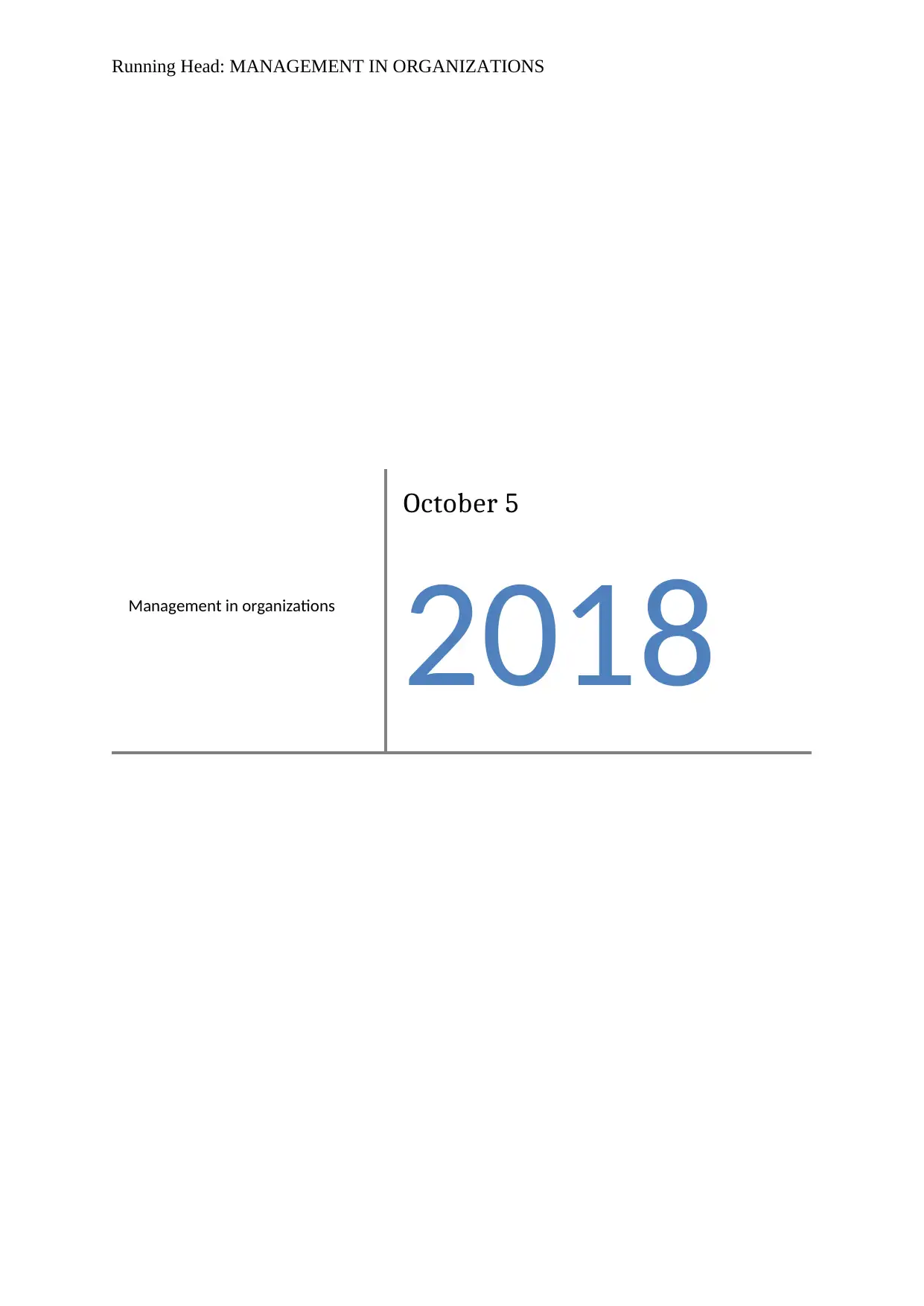
Running Head: MANAGEMENT IN ORGANIZATIONS
Management in organizations
October 5
2018
Management in organizations
October 5
2018
Paraphrase This Document
Need a fresh take? Get an instant paraphrase of this document with our AI Paraphraser
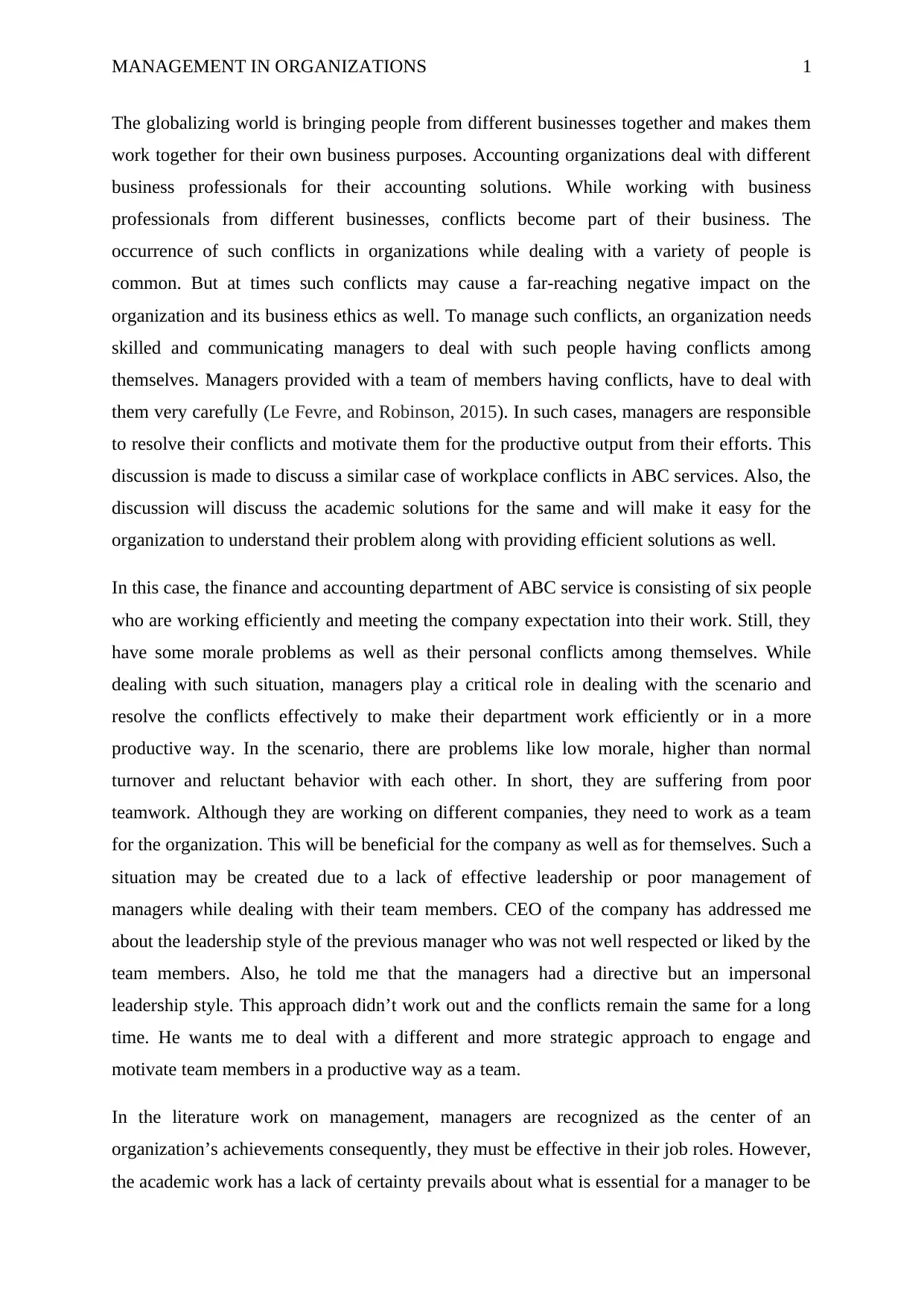
MANAGEMENT IN ORGANIZATIONS 1
The globalizing world is bringing people from different businesses together and makes them
work together for their own business purposes. Accounting organizations deal with different
business professionals for their accounting solutions. While working with business
professionals from different businesses, conflicts become part of their business. The
occurrence of such conflicts in organizations while dealing with a variety of people is
common. But at times such conflicts may cause a far-reaching negative impact on the
organization and its business ethics as well. To manage such conflicts, an organization needs
skilled and communicating managers to deal with such people having conflicts among
themselves. Managers provided with a team of members having conflicts, have to deal with
them very carefully (Le Fevre, and Robinson, 2015). In such cases, managers are responsible
to resolve their conflicts and motivate them for the productive output from their efforts. This
discussion is made to discuss a similar case of workplace conflicts in ABC services. Also, the
discussion will discuss the academic solutions for the same and will make it easy for the
organization to understand their problem along with providing efficient solutions as well.
In this case, the finance and accounting department of ABC service is consisting of six people
who are working efficiently and meeting the company expectation into their work. Still, they
have some morale problems as well as their personal conflicts among themselves. While
dealing with such situation, managers play a critical role in dealing with the scenario and
resolve the conflicts effectively to make their department work efficiently or in a more
productive way. In the scenario, there are problems like low morale, higher than normal
turnover and reluctant behavior with each other. In short, they are suffering from poor
teamwork. Although they are working on different companies, they need to work as a team
for the organization. This will be beneficial for the company as well as for themselves. Such a
situation may be created due to a lack of effective leadership or poor management of
managers while dealing with their team members. CEO of the company has addressed me
about the leadership style of the previous manager who was not well respected or liked by the
team members. Also, he told me that the managers had a directive but an impersonal
leadership style. This approach didn’t work out and the conflicts remain the same for a long
time. He wants me to deal with a different and more strategic approach to engage and
motivate team members in a productive way as a team.
In the literature work on management, managers are recognized as the center of an
organization’s achievements consequently, they must be effective in their job roles. However,
the academic work has a lack of certainty prevails about what is essential for a manager to be
The globalizing world is bringing people from different businesses together and makes them
work together for their own business purposes. Accounting organizations deal with different
business professionals for their accounting solutions. While working with business
professionals from different businesses, conflicts become part of their business. The
occurrence of such conflicts in organizations while dealing with a variety of people is
common. But at times such conflicts may cause a far-reaching negative impact on the
organization and its business ethics as well. To manage such conflicts, an organization needs
skilled and communicating managers to deal with such people having conflicts among
themselves. Managers provided with a team of members having conflicts, have to deal with
them very carefully (Le Fevre, and Robinson, 2015). In such cases, managers are responsible
to resolve their conflicts and motivate them for the productive output from their efforts. This
discussion is made to discuss a similar case of workplace conflicts in ABC services. Also, the
discussion will discuss the academic solutions for the same and will make it easy for the
organization to understand their problem along with providing efficient solutions as well.
In this case, the finance and accounting department of ABC service is consisting of six people
who are working efficiently and meeting the company expectation into their work. Still, they
have some morale problems as well as their personal conflicts among themselves. While
dealing with such situation, managers play a critical role in dealing with the scenario and
resolve the conflicts effectively to make their department work efficiently or in a more
productive way. In the scenario, there are problems like low morale, higher than normal
turnover and reluctant behavior with each other. In short, they are suffering from poor
teamwork. Although they are working on different companies, they need to work as a team
for the organization. This will be beneficial for the company as well as for themselves. Such a
situation may be created due to a lack of effective leadership or poor management of
managers while dealing with their team members. CEO of the company has addressed me
about the leadership style of the previous manager who was not well respected or liked by the
team members. Also, he told me that the managers had a directive but an impersonal
leadership style. This approach didn’t work out and the conflicts remain the same for a long
time. He wants me to deal with a different and more strategic approach to engage and
motivate team members in a productive way as a team.
In the literature work on management, managers are recognized as the center of an
organization’s achievements consequently, they must be effective in their job roles. However,
the academic work has a lack of certainty prevails about what is essential for a manager to be
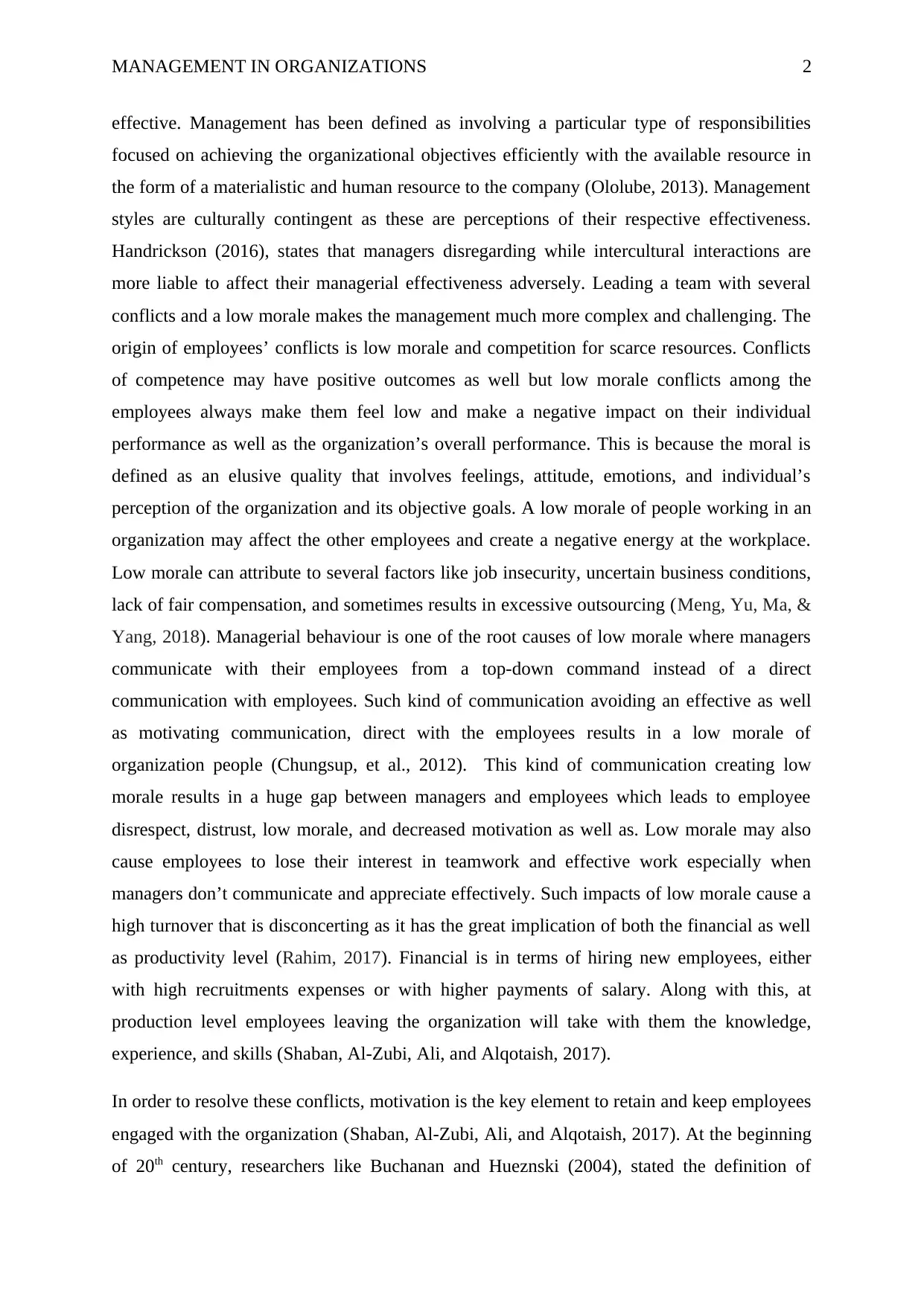
MANAGEMENT IN ORGANIZATIONS 2
effective. Management has been defined as involving a particular type of responsibilities
focused on achieving the organizational objectives efficiently with the available resource in
the form of a materialistic and human resource to the company (Ololube, 2013). Management
styles are culturally contingent as these are perceptions of their respective effectiveness.
Handrickson (2016), states that managers disregarding while intercultural interactions are
more liable to affect their managerial effectiveness adversely. Leading a team with several
conflicts and a low morale makes the management much more complex and challenging. The
origin of employees’ conflicts is low morale and competition for scarce resources. Conflicts
of competence may have positive outcomes as well but low morale conflicts among the
employees always make them feel low and make a negative impact on their individual
performance as well as the organization’s overall performance. This is because the moral is
defined as an elusive quality that involves feelings, attitude, emotions, and individual’s
perception of the organization and its objective goals. A low morale of people working in an
organization may affect the other employees and create a negative energy at the workplace.
Low morale can attribute to several factors like job insecurity, uncertain business conditions,
lack of fair compensation, and sometimes results in excessive outsourcing (Meng, Yu, Ma, &
Yang, 2018). Managerial behaviour is one of the root causes of low morale where managers
communicate with their employees from a top-down command instead of a direct
communication with employees. Such kind of communication avoiding an effective as well
as motivating communication, direct with the employees results in a low morale of
organization people (Chungsup, et al., 2012). This kind of communication creating low
morale results in a huge gap between managers and employees which leads to employee
disrespect, distrust, low morale, and decreased motivation as well as. Low morale may also
cause employees to lose their interest in teamwork and effective work especially when
managers don’t communicate and appreciate effectively. Such impacts of low morale cause a
high turnover that is disconcerting as it has the great implication of both the financial as well
as productivity level (Rahim, 2017). Financial is in terms of hiring new employees, either
with high recruitments expenses or with higher payments of salary. Along with this, at
production level employees leaving the organization will take with them the knowledge,
experience, and skills (Shaban, Al-Zubi, Ali, and Alqotaish, 2017).
In order to resolve these conflicts, motivation is the key element to retain and keep employees
engaged with the organization (Shaban, Al-Zubi, Ali, and Alqotaish, 2017). At the beginning
of 20th century, researchers like Buchanan and Hueznski (2004), stated the definition of
effective. Management has been defined as involving a particular type of responsibilities
focused on achieving the organizational objectives efficiently with the available resource in
the form of a materialistic and human resource to the company (Ololube, 2013). Management
styles are culturally contingent as these are perceptions of their respective effectiveness.
Handrickson (2016), states that managers disregarding while intercultural interactions are
more liable to affect their managerial effectiveness adversely. Leading a team with several
conflicts and a low morale makes the management much more complex and challenging. The
origin of employees’ conflicts is low morale and competition for scarce resources. Conflicts
of competence may have positive outcomes as well but low morale conflicts among the
employees always make them feel low and make a negative impact on their individual
performance as well as the organization’s overall performance. This is because the moral is
defined as an elusive quality that involves feelings, attitude, emotions, and individual’s
perception of the organization and its objective goals. A low morale of people working in an
organization may affect the other employees and create a negative energy at the workplace.
Low morale can attribute to several factors like job insecurity, uncertain business conditions,
lack of fair compensation, and sometimes results in excessive outsourcing (Meng, Yu, Ma, &
Yang, 2018). Managerial behaviour is one of the root causes of low morale where managers
communicate with their employees from a top-down command instead of a direct
communication with employees. Such kind of communication avoiding an effective as well
as motivating communication, direct with the employees results in a low morale of
organization people (Chungsup, et al., 2012). This kind of communication creating low
morale results in a huge gap between managers and employees which leads to employee
disrespect, distrust, low morale, and decreased motivation as well as. Low morale may also
cause employees to lose their interest in teamwork and effective work especially when
managers don’t communicate and appreciate effectively. Such impacts of low morale cause a
high turnover that is disconcerting as it has the great implication of both the financial as well
as productivity level (Rahim, 2017). Financial is in terms of hiring new employees, either
with high recruitments expenses or with higher payments of salary. Along with this, at
production level employees leaving the organization will take with them the knowledge,
experience, and skills (Shaban, Al-Zubi, Ali, and Alqotaish, 2017).
In order to resolve these conflicts, motivation is the key element to retain and keep employees
engaged with the organization (Shaban, Al-Zubi, Ali, and Alqotaish, 2017). At the beginning
of 20th century, researchers like Buchanan and Hueznski (2004), stated the definition of
⊘ This is a preview!⊘
Do you want full access?
Subscribe today to unlock all pages.

Trusted by 1+ million students worldwide
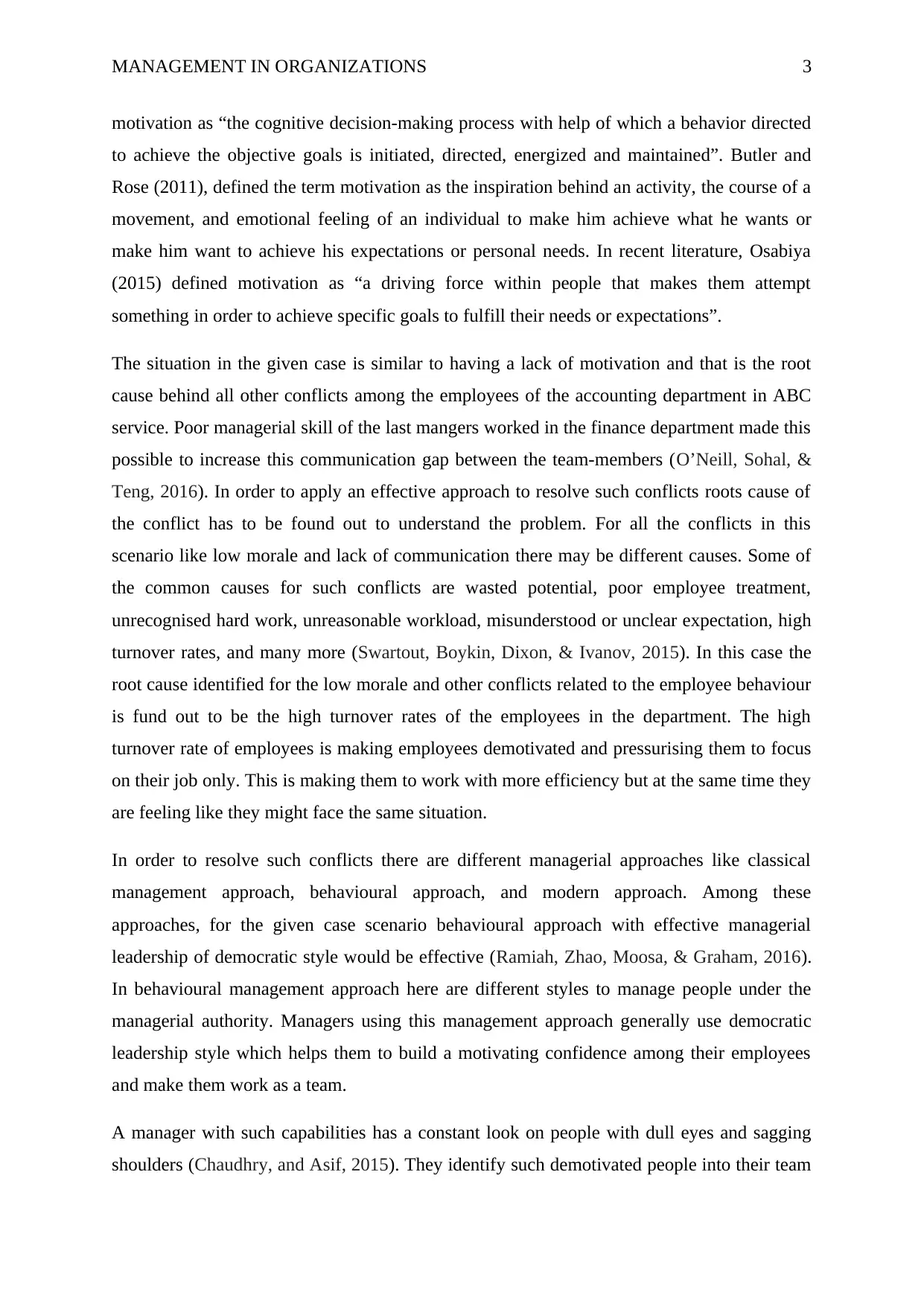
MANAGEMENT IN ORGANIZATIONS 3
motivation as “the cognitive decision-making process with help of which a behavior directed
to achieve the objective goals is initiated, directed, energized and maintained”. Butler and
Rose (2011), defined the term motivation as the inspiration behind an activity, the course of a
movement, and emotional feeling of an individual to make him achieve what he wants or
make him want to achieve his expectations or personal needs. In recent literature, Osabiya
(2015) defined motivation as “a driving force within people that makes them attempt
something in order to achieve specific goals to fulfill their needs or expectations”.
The situation in the given case is similar to having a lack of motivation and that is the root
cause behind all other conflicts among the employees of the accounting department in ABC
service. Poor managerial skill of the last mangers worked in the finance department made this
possible to increase this communication gap between the team-members (O’Neill, Sohal, &
Teng, 2016). In order to apply an effective approach to resolve such conflicts roots cause of
the conflict has to be found out to understand the problem. For all the conflicts in this
scenario like low morale and lack of communication there may be different causes. Some of
the common causes for such conflicts are wasted potential, poor employee treatment,
unrecognised hard work, unreasonable workload, misunderstood or unclear expectation, high
turnover rates, and many more (Swartout, Boykin, Dixon, & Ivanov, 2015). In this case the
root cause identified for the low morale and other conflicts related to the employee behaviour
is fund out to be the high turnover rates of the employees in the department. The high
turnover rate of employees is making employees demotivated and pressurising them to focus
on their job only. This is making them to work with more efficiency but at the same time they
are feeling like they might face the same situation.
In order to resolve such conflicts there are different managerial approaches like classical
management approach, behavioural approach, and modern approach. Among these
approaches, for the given case scenario behavioural approach with effective managerial
leadership of democratic style would be effective (Ramiah, Zhao, Moosa, & Graham, 2016).
In behavioural management approach here are different styles to manage people under the
managerial authority. Managers using this management approach generally use democratic
leadership style which helps them to build a motivating confidence among their employees
and make them work as a team.
A manager with such capabilities has a constant look on people with dull eyes and sagging
shoulders (Chaudhry, and Asif, 2015). They identify such demotivated people into their team
motivation as “the cognitive decision-making process with help of which a behavior directed
to achieve the objective goals is initiated, directed, energized and maintained”. Butler and
Rose (2011), defined the term motivation as the inspiration behind an activity, the course of a
movement, and emotional feeling of an individual to make him achieve what he wants or
make him want to achieve his expectations or personal needs. In recent literature, Osabiya
(2015) defined motivation as “a driving force within people that makes them attempt
something in order to achieve specific goals to fulfill their needs or expectations”.
The situation in the given case is similar to having a lack of motivation and that is the root
cause behind all other conflicts among the employees of the accounting department in ABC
service. Poor managerial skill of the last mangers worked in the finance department made this
possible to increase this communication gap between the team-members (O’Neill, Sohal, &
Teng, 2016). In order to apply an effective approach to resolve such conflicts roots cause of
the conflict has to be found out to understand the problem. For all the conflicts in this
scenario like low morale and lack of communication there may be different causes. Some of
the common causes for such conflicts are wasted potential, poor employee treatment,
unrecognised hard work, unreasonable workload, misunderstood or unclear expectation, high
turnover rates, and many more (Swartout, Boykin, Dixon, & Ivanov, 2015). In this case the
root cause identified for the low morale and other conflicts related to the employee behaviour
is fund out to be the high turnover rates of the employees in the department. The high
turnover rate of employees is making employees demotivated and pressurising them to focus
on their job only. This is making them to work with more efficiency but at the same time they
are feeling like they might face the same situation.
In order to resolve such conflicts there are different managerial approaches like classical
management approach, behavioural approach, and modern approach. Among these
approaches, for the given case scenario behavioural approach with effective managerial
leadership of democratic style would be effective (Ramiah, Zhao, Moosa, & Graham, 2016).
In behavioural management approach here are different styles to manage people under the
managerial authority. Managers using this management approach generally use democratic
leadership style which helps them to build a motivating confidence among their employees
and make them work as a team.
A manager with such capabilities has a constant look on people with dull eyes and sagging
shoulders (Chaudhry, and Asif, 2015). They identify such demotivated people into their team
Paraphrase This Document
Need a fresh take? Get an instant paraphrase of this document with our AI Paraphraser
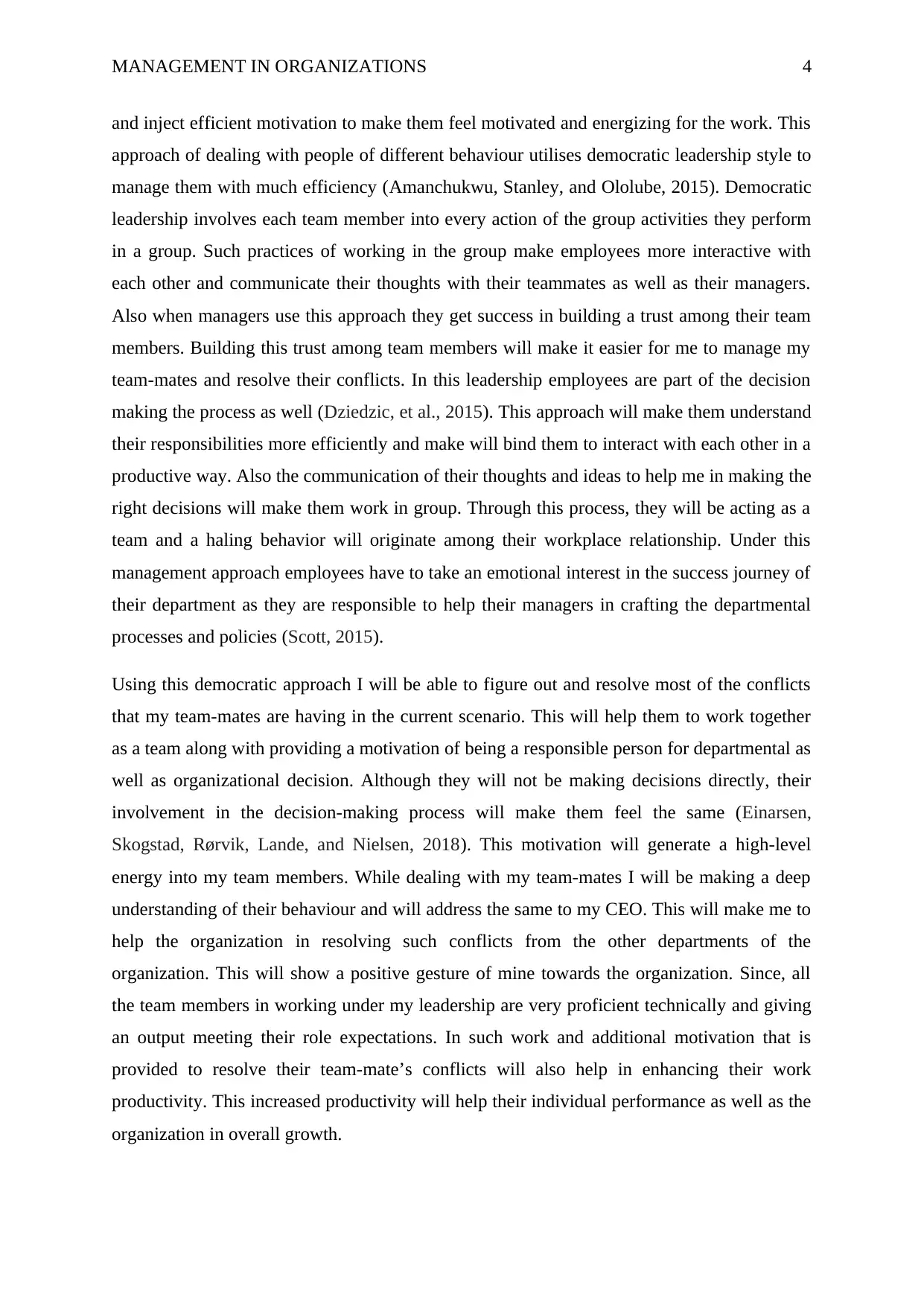
MANAGEMENT IN ORGANIZATIONS 4
and inject efficient motivation to make them feel motivated and energizing for the work. This
approach of dealing with people of different behaviour utilises democratic leadership style to
manage them with much efficiency (Amanchukwu, Stanley, and Ololube, 2015). Democratic
leadership involves each team member into every action of the group activities they perform
in a group. Such practices of working in the group make employees more interactive with
each other and communicate their thoughts with their teammates as well as their managers.
Also when managers use this approach they get success in building a trust among their team
members. Building this trust among team members will make it easier for me to manage my
team-mates and resolve their conflicts. In this leadership employees are part of the decision
making the process as well (Dziedzic, et al., 2015). This approach will make them understand
their responsibilities more efficiently and make will bind them to interact with each other in a
productive way. Also the communication of their thoughts and ideas to help me in making the
right decisions will make them work in group. Through this process, they will be acting as a
team and a haling behavior will originate among their workplace relationship. Under this
management approach employees have to take an emotional interest in the success journey of
their department as they are responsible to help their managers in crafting the departmental
processes and policies (Scott, 2015).
Using this democratic approach I will be able to figure out and resolve most of the conflicts
that my team-mates are having in the current scenario. This will help them to work together
as a team along with providing a motivation of being a responsible person for departmental as
well as organizational decision. Although they will not be making decisions directly, their
involvement in the decision-making process will make them feel the same (Einarsen,
Skogstad, Rørvik, Lande, and Nielsen, 2018). This motivation will generate a high-level
energy into my team members. While dealing with my team-mates I will be making a deep
understanding of their behaviour and will address the same to my CEO. This will make me to
help the organization in resolving such conflicts from the other departments of the
organization. This will show a positive gesture of mine towards the organization. Since, all
the team members in working under my leadership are very proficient technically and giving
an output meeting their role expectations. In such work and additional motivation that is
provided to resolve their team-mate’s conflicts will also help in enhancing their work
productivity. This increased productivity will help their individual performance as well as the
organization in overall growth.
and inject efficient motivation to make them feel motivated and energizing for the work. This
approach of dealing with people of different behaviour utilises democratic leadership style to
manage them with much efficiency (Amanchukwu, Stanley, and Ololube, 2015). Democratic
leadership involves each team member into every action of the group activities they perform
in a group. Such practices of working in the group make employees more interactive with
each other and communicate their thoughts with their teammates as well as their managers.
Also when managers use this approach they get success in building a trust among their team
members. Building this trust among team members will make it easier for me to manage my
team-mates and resolve their conflicts. In this leadership employees are part of the decision
making the process as well (Dziedzic, et al., 2015). This approach will make them understand
their responsibilities more efficiently and make will bind them to interact with each other in a
productive way. Also the communication of their thoughts and ideas to help me in making the
right decisions will make them work in group. Through this process, they will be acting as a
team and a haling behavior will originate among their workplace relationship. Under this
management approach employees have to take an emotional interest in the success journey of
their department as they are responsible to help their managers in crafting the departmental
processes and policies (Scott, 2015).
Using this democratic approach I will be able to figure out and resolve most of the conflicts
that my team-mates are having in the current scenario. This will help them to work together
as a team along with providing a motivation of being a responsible person for departmental as
well as organizational decision. Although they will not be making decisions directly, their
involvement in the decision-making process will make them feel the same (Einarsen,
Skogstad, Rørvik, Lande, and Nielsen, 2018). This motivation will generate a high-level
energy into my team members. While dealing with my team-mates I will be making a deep
understanding of their behaviour and will address the same to my CEO. This will make me to
help the organization in resolving such conflicts from the other departments of the
organization. This will show a positive gesture of mine towards the organization. Since, all
the team members in working under my leadership are very proficient technically and giving
an output meeting their role expectations. In such work and additional motivation that is
provided to resolve their team-mate’s conflicts will also help in enhancing their work
productivity. This increased productivity will help their individual performance as well as the
organization in overall growth.
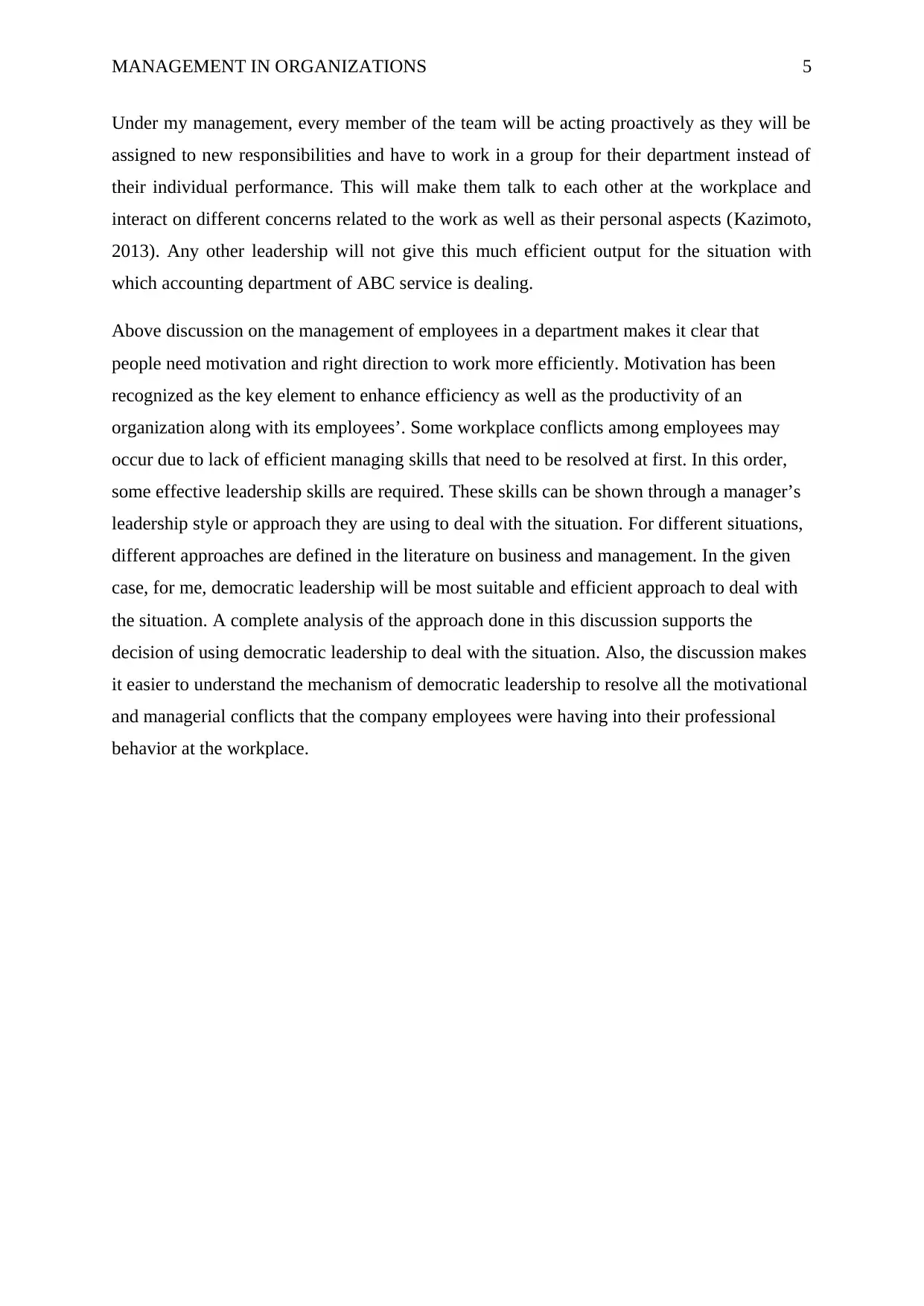
MANAGEMENT IN ORGANIZATIONS 5
Under my management, every member of the team will be acting proactively as they will be
assigned to new responsibilities and have to work in a group for their department instead of
their individual performance. This will make them talk to each other at the workplace and
interact on different concerns related to the work as well as their personal aspects (Kazimoto,
2013). Any other leadership will not give this much efficient output for the situation with
which accounting department of ABC service is dealing.
Above discussion on the management of employees in a department makes it clear that
people need motivation and right direction to work more efficiently. Motivation has been
recognized as the key element to enhance efficiency as well as the productivity of an
organization along with its employees’. Some workplace conflicts among employees may
occur due to lack of efficient managing skills that need to be resolved at first. In this order,
some effective leadership skills are required. These skills can be shown through a manager’s
leadership style or approach they are using to deal with the situation. For different situations,
different approaches are defined in the literature on business and management. In the given
case, for me, democratic leadership will be most suitable and efficient approach to deal with
the situation. A complete analysis of the approach done in this discussion supports the
decision of using democratic leadership to deal with the situation. Also, the discussion makes
it easier to understand the mechanism of democratic leadership to resolve all the motivational
and managerial conflicts that the company employees were having into their professional
behavior at the workplace.
Under my management, every member of the team will be acting proactively as they will be
assigned to new responsibilities and have to work in a group for their department instead of
their individual performance. This will make them talk to each other at the workplace and
interact on different concerns related to the work as well as their personal aspects (Kazimoto,
2013). Any other leadership will not give this much efficient output for the situation with
which accounting department of ABC service is dealing.
Above discussion on the management of employees in a department makes it clear that
people need motivation and right direction to work more efficiently. Motivation has been
recognized as the key element to enhance efficiency as well as the productivity of an
organization along with its employees’. Some workplace conflicts among employees may
occur due to lack of efficient managing skills that need to be resolved at first. In this order,
some effective leadership skills are required. These skills can be shown through a manager’s
leadership style or approach they are using to deal with the situation. For different situations,
different approaches are defined in the literature on business and management. In the given
case, for me, democratic leadership will be most suitable and efficient approach to deal with
the situation. A complete analysis of the approach done in this discussion supports the
decision of using democratic leadership to deal with the situation. Also, the discussion makes
it easier to understand the mechanism of democratic leadership to resolve all the motivational
and managerial conflicts that the company employees were having into their professional
behavior at the workplace.
⊘ This is a preview!⊘
Do you want full access?
Subscribe today to unlock all pages.

Trusted by 1+ million students worldwide
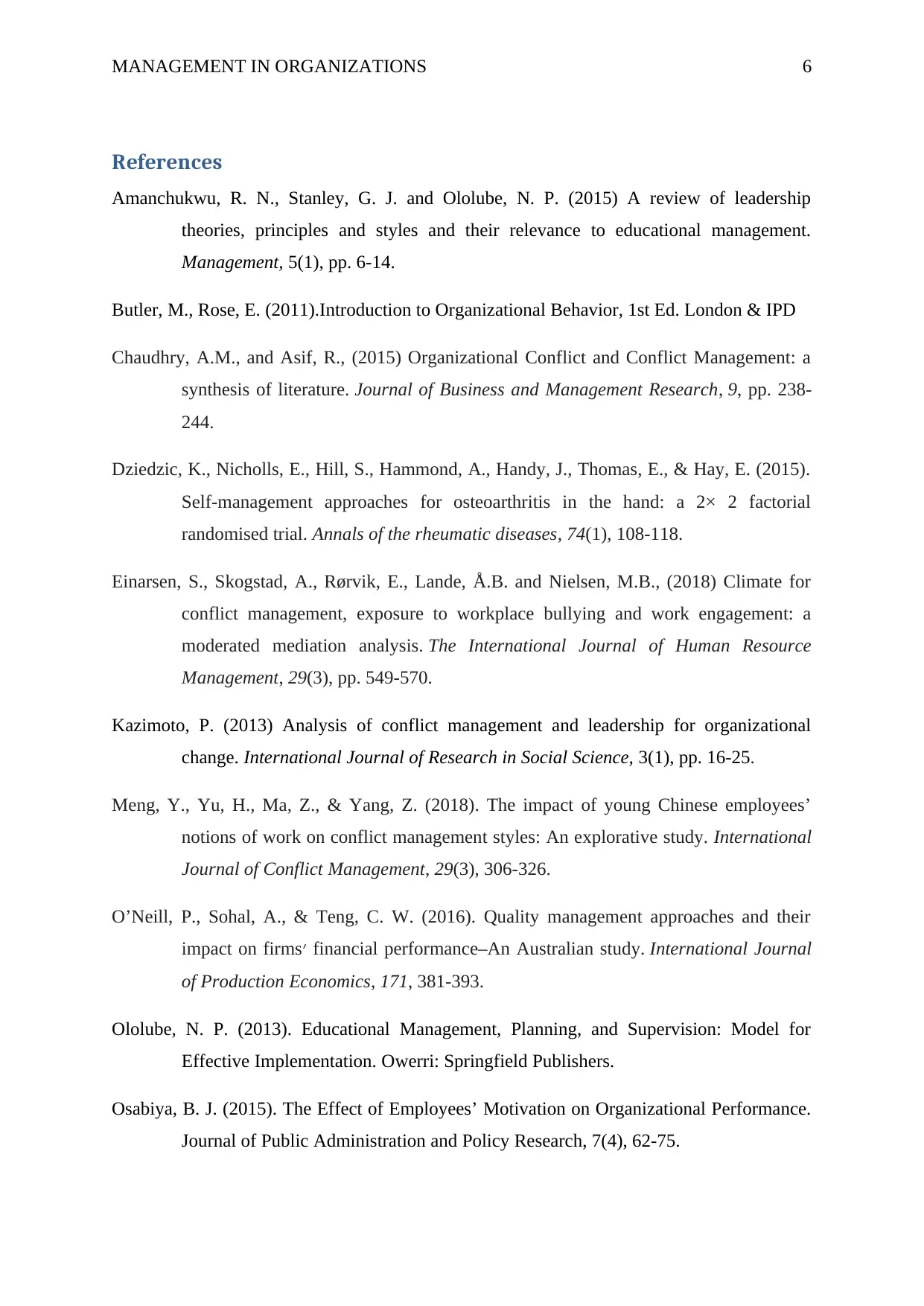
MANAGEMENT IN ORGANIZATIONS 6
References
Amanchukwu, R. N., Stanley, G. J. and Ololube, N. P. (2015) A review of leadership
theories, principles and styles and their relevance to educational management.
Management, 5(1), pp. 6-14.
Butler, M., Rose, E. (2011).Introduction to Organizational Behavior, 1st Ed. London & IPD
Chaudhry, A.M., and Asif, R., (2015) Organizational Conflict and Conflict Management: a
synthesis of literature. Journal of Business and Management Research, 9, pp. 238-
244.
Dziedzic, K., Nicholls, E., Hill, S., Hammond, A., Handy, J., Thomas, E., & Hay, E. (2015).
Self-management approaches for osteoarthritis in the hand: a 2× 2 factorial
randomised trial. Annals of the rheumatic diseases, 74(1), 108-118.
Einarsen, S., Skogstad, A., Rørvik, E., Lande, Å.B. and Nielsen, M.B., (2018) Climate for
conflict management, exposure to workplace bullying and work engagement: a
moderated mediation analysis. The International Journal of Human Resource
Management, 29(3), pp. 549-570.
Kazimoto, P. (2013) Analysis of conflict management and leadership for organizational
change. International Journal of Research in Social Science, 3(1), pp. 16-25.
Meng, Y., Yu, H., Ma, Z., & Yang, Z. (2018). The impact of young Chinese employees’
notions of work on conflict management styles: An explorative study. International
Journal of Conflict Management, 29(3), 306-326.
O’Neill, P., Sohal, A., & Teng, C. W. (2016). Quality management approaches and their
impact on firms׳ financial performance–An Australian study. International Journal
of Production Economics, 171, 381-393.
Ololube, N. P. (2013). Educational Management, Planning, and Supervision: Model for
Effective Implementation. Owerri: Springfield Publishers.
Osabiya, B. J. (2015). The Effect of Employees’ Motivation on Organizational Performance.
Journal of Public Administration and Policy Research, 7(4), 62-75.
References
Amanchukwu, R. N., Stanley, G. J. and Ololube, N. P. (2015) A review of leadership
theories, principles and styles and their relevance to educational management.
Management, 5(1), pp. 6-14.
Butler, M., Rose, E. (2011).Introduction to Organizational Behavior, 1st Ed. London & IPD
Chaudhry, A.M., and Asif, R., (2015) Organizational Conflict and Conflict Management: a
synthesis of literature. Journal of Business and Management Research, 9, pp. 238-
244.
Dziedzic, K., Nicholls, E., Hill, S., Hammond, A., Handy, J., Thomas, E., & Hay, E. (2015).
Self-management approaches for osteoarthritis in the hand: a 2× 2 factorial
randomised trial. Annals of the rheumatic diseases, 74(1), 108-118.
Einarsen, S., Skogstad, A., Rørvik, E., Lande, Å.B. and Nielsen, M.B., (2018) Climate for
conflict management, exposure to workplace bullying and work engagement: a
moderated mediation analysis. The International Journal of Human Resource
Management, 29(3), pp. 549-570.
Kazimoto, P. (2013) Analysis of conflict management and leadership for organizational
change. International Journal of Research in Social Science, 3(1), pp. 16-25.
Meng, Y., Yu, H., Ma, Z., & Yang, Z. (2018). The impact of young Chinese employees’
notions of work on conflict management styles: An explorative study. International
Journal of Conflict Management, 29(3), 306-326.
O’Neill, P., Sohal, A., & Teng, C. W. (2016). Quality management approaches and their
impact on firms׳ financial performance–An Australian study. International Journal
of Production Economics, 171, 381-393.
Ololube, N. P. (2013). Educational Management, Planning, and Supervision: Model for
Effective Implementation. Owerri: Springfield Publishers.
Osabiya, B. J. (2015). The Effect of Employees’ Motivation on Organizational Performance.
Journal of Public Administration and Policy Research, 7(4), 62-75.
Paraphrase This Document
Need a fresh take? Get an instant paraphrase of this document with our AI Paraphraser
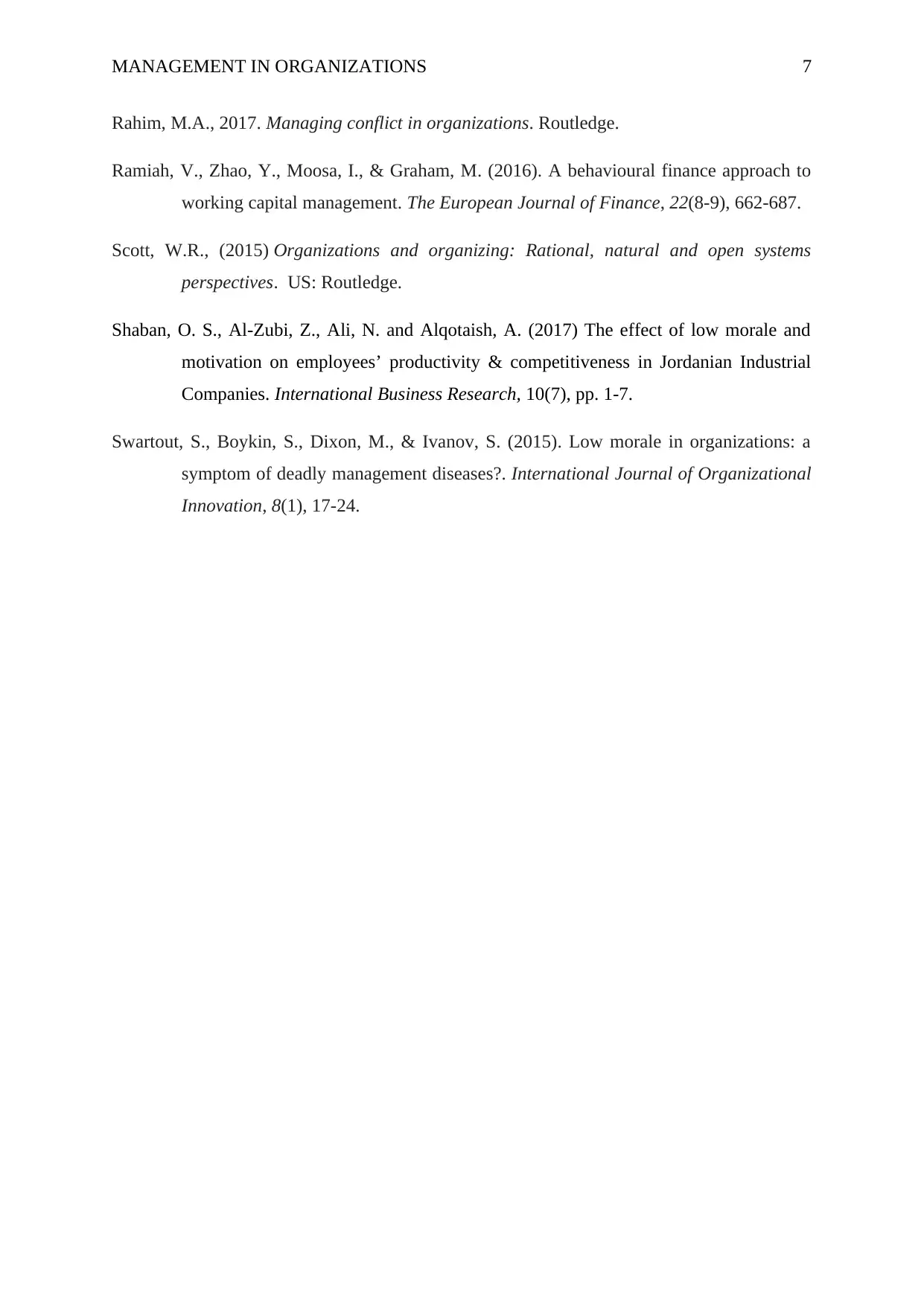
MANAGEMENT IN ORGANIZATIONS 7
Rahim, M.A., 2017. Managing conflict in organizations. Routledge.
Ramiah, V., Zhao, Y., Moosa, I., & Graham, M. (2016). A behavioural finance approach to
working capital management. The European Journal of Finance, 22(8-9), 662-687.
Scott, W.R., (2015) Organizations and organizing: Rational, natural and open systems
perspectives. US: Routledge.
Shaban, O. S., Al-Zubi, Z., Ali, N. and Alqotaish, A. (2017) The effect of low morale and
motivation on employees’ productivity & competitiveness in Jordanian Industrial
Companies. International Business Research, 10(7), pp. 1-7.
Swartout, S., Boykin, S., Dixon, M., & Ivanov, S. (2015). Low morale in organizations: a
symptom of deadly management diseases?. International Journal of Organizational
Innovation, 8(1), 17-24.
Rahim, M.A., 2017. Managing conflict in organizations. Routledge.
Ramiah, V., Zhao, Y., Moosa, I., & Graham, M. (2016). A behavioural finance approach to
working capital management. The European Journal of Finance, 22(8-9), 662-687.
Scott, W.R., (2015) Organizations and organizing: Rational, natural and open systems
perspectives. US: Routledge.
Shaban, O. S., Al-Zubi, Z., Ali, N. and Alqotaish, A. (2017) The effect of low morale and
motivation on employees’ productivity & competitiveness in Jordanian Industrial
Companies. International Business Research, 10(7), pp. 1-7.
Swartout, S., Boykin, S., Dixon, M., & Ivanov, S. (2015). Low morale in organizations: a
symptom of deadly management diseases?. International Journal of Organizational
Innovation, 8(1), 17-24.
1 out of 8
Related Documents
Your All-in-One AI-Powered Toolkit for Academic Success.
+13062052269
info@desklib.com
Available 24*7 on WhatsApp / Email
![[object Object]](/_next/static/media/star-bottom.7253800d.svg)
Unlock your academic potential
Copyright © 2020–2025 A2Z Services. All Rights Reserved. Developed and managed by ZUCOL.





